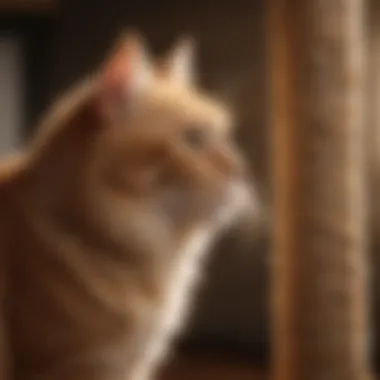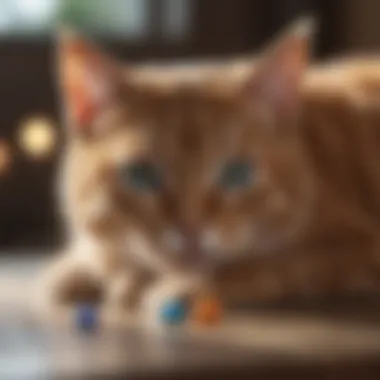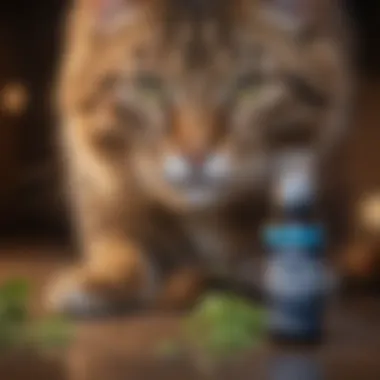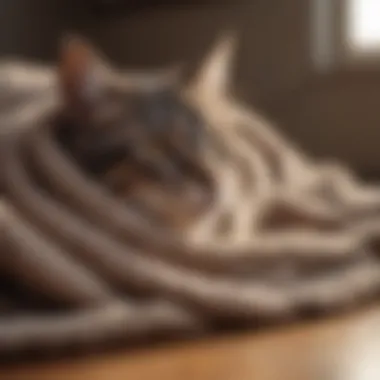Expert Strategies to Prevent Your Cat from Scratching Furniture


Pet Care Essentials
When it comes to ensuring the well-being of your feline friend and the protection of your furniture, understanding pet care essentials is crucial. This section will delve into the daily nutrition requirements, exercise and playtime needs, grooming tips, and health and wellness check-ins necessary for maintaining a harmonious environment for both you and your cat.
Daily Nutrition Requirements
Proper nutrition plays a significant role in curbing destructive scratching behavior in cats. By providing a balanced diet rich in essential nutrients and vitamins, you can help meet your cat's physiological needs, which in turn contributes to their overall health and behavior.
Exercise and Playtime
Adequate exercise and playtime are vital for cats to expend their energy positively. Engaging your feline companion in interactive play sessions not only stimulates their mind but also allows them to hone their natural hunting instincts, reducing the likelihood of them resorting to furniture scratching out of boredom.
Grooming Tips
Regular grooming not only helps maintain your cat's coat and skin health but also promotes bonding between you and your pet. Proper grooming practices, such as nail trimming, can also aid in keeping your cat's claws at a manageable length, lessening the need for them to scratch excessively.
Health and Wellness Check-ins
Regular health check-ups aid in early detection of any underlying medical issues that could be triggering your cat's scratching behavior. By staying proactive in monitoring your cat's health and addressing any potential concerns promptly, you can support their overall well-being and prevent unwanted furniture damage.
Understanding Cat Scratching Behavior
Understanding the behavior of cat scratching is crucial in addressing this common issue among pet owners. By delving into the reasons behind why cats exhibit this behavior, individuals can effectively implement strategies to prevent furniture damage. This section provides an in-depth analysis of the innate instincts driving cats to scratch, their territorial marking tendencies, and the importance of nail maintenance.
Reasons Behind Cat Scratching
Natural Instincts
Natural instincts play a significant role in cat scratching behavior. Cats have an innate need to scratch to sharpen their claws, stretch their muscles, and mark their territory. Understanding these primal urges is essential to provide suitable outlets for scratching while protecting furniture. While natural instincts are beneficial for cats' well-being, it can be challenging for pet owners to redirect this behavior away from household items.
Marking Territory
Marking territory is another key aspect of cat scratching behavior. Cats have scent glands in their paws that release pheromones when they scratch, signaling their presence and establishing ownership of a particular space. This behavior is essential for cats to feel secure in their environment but can result in damage to furniture. Balancing the need for territorial marking with preserving household items requires strategic intervention and redirection techniques.


Nail Maintenance
Apart from fulfilling their natural instincts and territorial marking, cat scratching is essential for nail maintenance. Scratching helps cats shed old claw sheaths, promoting healthy nail growth and preventing overgrowth. By understanding the role of scratching in maintaining nail health, pet owners can facilitate this biological need through appropriate scratching surfaces.
Types of Surfaces Cats Prefer
Texture Preferences
Cats have specific preferences when it comes to scratching surfaces. Texture plays a vital role in attracting felines to scratch, with materials like sisal rope, carpet, and cardboard being popular choices. Understanding cats' texture preferences helps in selecting scratching posts and pads that cater to their instincts, reducing the likelihood of furniture damage. While accommodating cats' texture preferences is advantageous, it also requires experimentation to find the most appealing options.
Height Preference
In addition to textures, cats also have height preferences for scratching surfaces. Cats enjoy stretching vertically while scratching, simulating natural behaviors like climbing and scratching tree trunks. Providing tall scratching posts or cat trees mimics outdoor environments, fulfilling cats' need for vertical scratching. Incorporating elevated scratching options offers cats physical and mental stimulation while protecting furniture from scratching damage.
Impact on Cat's Well-being
Physical Health
Cat scratching behavior has a direct impact on feline physical health. Regular scratching aids in maintaining healthy claws, promoting circulation, and stretching muscles. By fostering opportunities for cats to scratch, owners contribute to their pets' overall well-being and prevent potential health issues related to inactive claws. Prioritizing physical health through appropriate scratching outlets ensures cats remain active and healthy.
Mental Stimulation
In addition to physical benefits, scratching provides essential mental stimulation for cats. Engaging in scratching activities allows cats to relieve stress, express natural behaviors, and stay mentally alert. Cat furniture that encourages scratching helps prevent boredom and behavioral problems, promoting a harmonious environment for both pets and owners. Prioritizing mental stimulation through scratching outlets enriches cats' lives and enhances their overall welfare.
Effective Strategies for Redirection
In the realm of preventing cats from scratching furniture, the pivotal aspect lies in effective redirection strategies. These tactics play a crucial role in preserving your furniture and ensuring the well-being of your feline companions. By implementing these strategies, you can channel your cat's natural instincts towards more suitable alternatives. Additionally, redirection strategies help in creating a harmonious environment where both you and your cat are content.
Providing Suitable Alternatives
Scratching Posts
Scratching posts are essential when it comes to redirecting a cat's scratching behavior. Their key characteristic lies in providing a designated area for cats to fulfill their scratching needs. These posts offer a rough texture that appeals to cats, encouraging them to use the post instead of your furniture. Scratching posts are a popular choice due to their effectiveness in diverting a cat's attention away from sofas and chairs. However, some cats may prefer certain textures, so it's crucial to experiment to find the most appealing scratching post for your feline friend.
Cardboard Scratching Pads


Cardboard scratching pads serve as an excellent alternative for cats who enjoy different textures. These pads are lightweight and easily disposable, making them a convenient option for both cats and owners. The unique feature of cardboard scratching pads is their cost-effectiveness and eco-friendly nature. While they provide a temporary scratching solution, some cats might find them less engaging than other options.
Cat Trees
Cat trees are multi-level structures that offer various scratching surfaces, resting spots, and hideaways. These trees cater to a cat's need for vertical space, allowing them to climb, scratch, and observe their surroundings from a higher vantage point. Their key characteristic lies in providing a comprehensive activity center for cats, fulfilling both their scratching and climbing instincts. Cat trees provide enrichment and exercise opportunities for cats, but they require sufficient space and may not be suitable for smaller living areas.
Incorporating Interactive Toys
Feather Wands
Feather wands are interactive toys that mimic the movement of birds, enticing cats to engage in play. Their key characteristic is the natural appearance of feathers, which triggers a cat's predatory instincts and encourages pouncing and chasing. Feather wands are a popular choice for bonding with your cat and providing mental stimulation. However, caution is necessary to prevent any accidental ingestion of feathers.
Interactive Laser Toys
Interactive laser toys emit a laser beam that can be directed across surfaces, allowing cats to chase and 'catch' the elusive light. The key characteristic of these toys is the unpredictable nature of the laser, keeping cats entertained and engaged. Interactive laser toys are beneficial for encouraging exercise in cats with low mobility and stimulating their hunting behavior. However, it's essential to avoid shining the laser directly into a cat's eyes.
Using Deterrents
Citrus Spray
Citrus spray is a natural deterrent that cats typically find unpleasant due to their aversion to citrus scents. The key characteristic of citrus spray is its ability to discourage cats from scratching or marking certain areas. This spray is a popular choice for pet owners looking to protect specific furniture pieces without causing harm to their cats. However, individual cats may have differing reactions to citrus scents.
Double-Sided Tape
Double-sided tape serves as a tactile deterrent by creating an unpleasant texture for cats when they attempt to scratch a surface. The key characteristic of double-sided tape is its easy application and removal, making it a practical solution for protecting furniture temporarily. This tape is a non-invasive method of deterring scratching behavior but may require consistent reapplication to remain effective.
Scent Repellents
Scent repellents utilize natural or synthetic fragrances that cats find repulsive, discouraging them from scratching specific areas. The key characteristic of scent repellents is their versatility in deterring various unwanted behaviors beyond scratching. These repellents offer a subtle way to modify your cat's behavior without causing them distress. However, some cats may become accustomed to certain scents over time, reducing their deterrent effectiveness.
Behavioral Modifications and Training Techniques
Begin by exploring the vital role of Behavioral Modifications and Training Techniques within the scope of preventing cats from scratching furniture. This section delves into the specific elements and benefits these techniques provide. Behavioral Modifications and Training Techniques are essential as they help in fostering positive behaviors in cats, steering them away from destructive scratching habits. By incorporating these techniques, pet owners can effectively communicate acceptable behavior to their feline companions, promoting a harmonious living environment. Considerations about Behavioral Modifications and Training Techniques include the need for patience, consistency, and understanding the individual personalities of the cats to tailor an effective training approach.
Positive Reinforcement


Rewarding Good Behavior
In discussing the aspect of Rewarding Good Behavior, it is imperative to underline its significance in encouraging desirable actions in cats. Rewarding Good Behavior involves praising or providing treats to cats when they exhibit positive behaviors such as using designated scratching posts. This method reinforces the association between good behavior and pleasant outcomes, motivating cats to continue such behavior. Its effectiveness lies in the immediacy of the reward and the positive reinforcement it offers, which aids in shaping and maintaining favorable habits. While Rewarding Good Behavior is a popular choice for its efficacy, it requires consistency and accuracy in timing to be truly impactful. Pet owners must ensure the reward is relevant to the cat and delivered promptly to reinforce the desired behavior.
Clicker Training
Exploring Clicker Training as a method within Positive Reinforcement is pivotal for this article's overarching goal. Clicker Training involves using a clicker tool to produce a distinct sound, followed by a treat to mark and reward desired behaviors. The key characteristic of Clicker Training is its ability to pinpoint precise moments of desired behavior, facilitating clear communication between pet and owner. This technique is favored for its direct association between the click sound and the subsequent treat, enabling cats to understand and replicate the behavior quickly. The unique feature of Clicker Training is its versatility in shaping a wide range of behaviors while maintaining a positive learning environment. Although effective, Clicker Training demands consistency and patience from pet owners to yield sustainable results.
Discouraging Undesirable Behavior
Avoiding Punishment
When tackling the aspect of Avoiding Punishment, it is imperative to highlight its role in fostering a positive and stress-free training environment. Avoiding Punishment promotes a constructive approach where undesirable behaviors are not met with harsh reprimands that can instill fear in cats. Instead, emphasis is placed on redirecting inappropriate actions towards more acceptable alternatives. The key characteristic of Avoiding Punishment is its focus on nurturing a trusting bond between pets and owners through positive interactions. This approach minimizes the risk of creating negative associations or anxiety in cats, promoting a healthy training environment. While eschewing punishment is widely preferred for its long-term benefits, it requires consistent application and reinforcement of desired behaviors to be effective.
Redirecting Attention
In the context of Redirecting Attention, its significance within discouraging undesirable scratching behaviors cannot be overstated. Redirecting Attention entails diverting a cat's focus from destructive actions towards engaging and interactive stimuli such as toys or play sessions. By providing alternative outlets for energy and instinctual behaviors, cats can be gently guided away from unwanted scratching habits. The key characteristic of Redirecting Attention is its ability to shift a cat's attention seamlessly, preventing or interrupting undesirable behavior without causing stress or anxiety. This approach is favored for its effectiveness in fostering positive interactions and minimizing conflicts between pets and owners. The unique feature of Redirecting Attention lies in its capacity to reinforce positive behaviors through redirecting natural instincts, creating a fulfilling training experience.
Establishing Routine and Consistency
Regular Play Sessions
Delve into the importance of Regular Play Sessions as a fundamental aspect of maintaining a harmonious environment for cats. Regular Play Sessions offer cats a structured outlet for energy, mental stimulation, and exercise, reducing the likelihood of resorting to furniture scratching out of boredom or excess energy. The key characteristic of Regular Play Sessions is its ability to mimic natural hunting and exploring behaviors, fulfilling cats' innate needs for physical and mental engagement. By integrating play sessions into daily routines, pet owners can establish a bond with their cats and provide a positive reinforcement outlet, strengthening the human-feline relationship. While Regular Play Sessions are popular for their numerous health and behavioral benefits, consistency in timing and type of play is crucial for long-term success.
Maintaining Scratch-Friendly Environment
Dive into the significance of Maintaining a Scratch-Friendly Environment to promote positive scratching behavior in cats. This aspect focuses on providing cats with suitable scratching surfaces like scratching posts or pads, ensuring they have an appropriate outlet for their natural scratching instincts. The key characteristic of a Scratch-Friendly Environment is its ability to redirect scratching activities away from furniture towards designated surfaces, preserving household items. By strategically placing scratching posts in key locations and incorporating catnip or toys to attract cats, pet owners can effectively deter furniture damage. The unique feature of a Scratch-Friendly Environment lies in its role in satisfying cats' instinctual needs while safeguarding home furnishings. While crucial for discouraging furniture scratching, maintaining a Scratch-Friendly Environment necessitates regular monitoring and occasional surface replacement to ensure cats remain engaged and satisfied with the designated scratching areas.
Seeking Professional Assistance
Seeking professional assistance when dealing with your cat's furniture scratching behavior is a crucial step in ensuring a harmonious living environment for both you and your feline friend. Consulting a veterinarian or behaviorist can provide valuable insights into the root causes of your cat's behavior and offer tailored solutions to address it effectively. These professionals have the expertise to identify underlying issues that may be triggering your cat's scratching behavior and can recommend suitable behavioral interventions to modify this conduct. The collaborative effort between pet owners and professionals fosters a holistic approach towards resolving such behavioral concerns, promoting a healthier relationship between humans and their pets.
Consulting a Veterinarian or Behaviorist
Identifying Underlying Issues
Identifying underlying issues through the assistance of a veterinarian or behaviorist is a pivotal aspect of addressing your cat's furniture scratching behavior. By delving into the root causes of why your cat engages in this behavior, professionals can unveil any physical discomfort, stress, or environmental factors contributing to the scratching habit. This thorough examination aids in developing targeted intervention strategies that prioritize your cat's well-being and overall behavioral health. The diagnostic prowess of experts in pinpointing these underlying issues serves as a cornerstone in crafting effective solutions tailored to your cat's specific needs.
Behavioral Therapy
Behavioral therapy stands out as a strategic tool in the armamentarium of professional intervention for addressing cat scratching behavior. Through targeted behavior modification techniques and reinforcement strategies, behavioral therapy endeavors to reshape your cat's scratching conduct towards more desirable outlets. This structured approach emphasizes substituting unwanted behaviors with positive alternatives, encouraging your cat to engage in more appropriate activities that align with your household rules. The specialized guidance offered in behavioral therapy equips pet owners with the knowledge and skills to implement consistent and rewarding training practices, fostering lasting behavioral changes in their feline companions.







